“Come on over, I’ll take you to La Tuf brewery so you can meet everyone. It’s like our Cheers.”
Even though I’ve been living in Toulon, on France’s southern coast, for 12 years—and love everything about it here—there are times when I crave an English-speaking expat hit.
With this in mind, I reached out to a friend, Susana, with the idea of visiting her in the village of Cotignac, where expats are as plentiful as the rosé vineyards that surround this corner of Provence.
It seemed just the place to go in search of some expat kindred spirits, and I was not disappointed: Canadians, Americans, Norwegians, Germans, and others have all settled happily here. And it was obvious why…
Are you interested in retiring abroad? Yes | Not Sure Yet
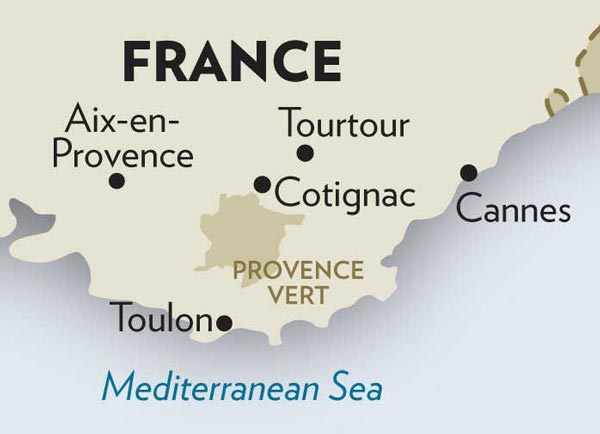
Gourmet Living in Green Provence
This is “Green Provence”—a wonderfully tranquil part of inland Provence where the villages are unspoiled and life and good food are savored. Picture honey-colored stone houses surrounding small squares, perhaps with a frenzy of scarlet geraniums tumbling from a window box…
You’ll find the famous Provencal fields of fragrant lavender and olive groves and winding roads lined with Cotes-de-Provence vineyards leading to spectacular limestone cliffs and waterfalls, curiously flat-topped mountains and one of the most stunning river canyons in Europe, the Gorges du Verdon, whose waters are a dazzling crystal-green.
Cotignac is in the heart of Provence Verte (Green Provence). Just one of the many enchanting and timeless villages that have captured the hearts of expats from all over.
You’re about an hour from the beaches of the Mediterranean here, surrounded by lush vineyards. Life is lived outdoors with plenty of hiking, cycling, paddling, and more to keep you occupied.
An enviable gourmet lifestyle is another of the region’s main attractions. While traditional French bistros abound, Provence Verte is increasingly seen as a foodie destination par excellence.
Expats are as plentiful as the rosé vineyards.
This year’s Michelin Guide distributed its coveted stars to 10 restaurants in the Var department (the region’s administrative district), with four of those stars landing in Green Provence. You don’t need deep pockets or a refined palette to dine in the region, nor will you find upturned noses or snooty table settings. Fine dining exists, without a doubt, but it doesn’t come with pretention…or inflated prices.
Take the four-course “Truffle Menu” at Bruno restaurant in the town of Lorgues for €89 ($94).
And just as inviting is Bruno’s neighbor down the street, Bistro Chez Ludo. I sampled their lunch menu (menu du jour), late last October which included a Provençal terrine of herbed charcuterie with slow-braised shredded pork and a creamy potato Dauphinois gratin for €17 ($18).
It’s no wonder that the region attracts everyone from truffle farmers to celebrity chefs and Hollywood stars like Brad Pitt and George Lucas, who own wine estates near the villages of Correns and Chateauvert, respectively.
Real Estate In “Green Provence”
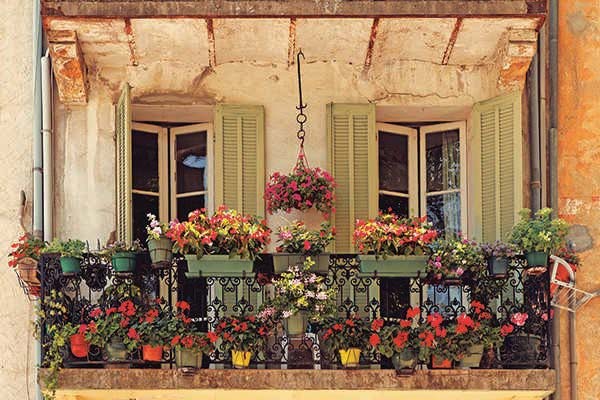
Even though real estate offerings in Cotignac are a bargain compared to what we pay along the coast, French and expats alike remarked that prices are around 20% more expensive than surrounding villages in other parts of Green Provence.
Two-bedroom, 1,075-square-foot village houses in the center of Cotignac can be found for around €240,000 ($257,060), although those larger homes on the hill were likely to go for €400,000 ($428,495) and up.
Here’s one listing in Cotignac that is currently on the market: A three-bedroom, three-bathroom house right in the heart of the village. It also has a living room, a small kitchen, an office, and a workroom. It’s been renovated and has underfloor heating. The asking price is €336,000 ($359,890).
As for rentals, two-bedroom, one-bathroom (970 square feet) rental apartments are priced at €800 ($856), and short-term rentals are plentiful year-round. Apartments for purchase start at about €190,000 ($203,530) for two bedrooms and one bathroom.
To give you an example of what you can find in villages close by: Famed for its 42 fountains and close to the lake of Sainte- Croix, the village of Barjols is the perfect Provencal hideaway to play petanque (French bowls), and relax on the shady terrace of a café. I came across one listing for a village house with its own billiard room, courtyard, and two bedrooms for €160,000 ($171,410). It needs some work but the flagstone floors and wooden beams will appeal to any romantic dreaming of a south of France retreat. Barjols is just 20 minutes from Cotignac.
Where Everyone Knows Your Name
I met Susana in her adopted hometown, Cotignac. She greeted me, smiling from ear-to-ear, with a chilled bottle of Champagne peeping out of her tote bag.
Although totally delighted, I had to admit that I wasn’t entirely surprised. She was just that kind of person. Nobody sneezed, opened a B&B, or hosted an art exhibition in Cotignac without Susana knowing about it.
She’d even managed to secure a night’s stay for me at Lou Calen (see: loucalen.com), a luxury hotel complex spread over 7 acres with a gourmet restaurant (Jardin Secret), wine bar, and microbrewery we’d be visiting later that evening, La Tuf.
In the quiet of my lodgings, which turned out to be the best digs on the property, Susana talked me through her life in Cotignac.
She’d split her time between Berkeley and Los Angeles in the 80s to mid-90s, having spent much of her childhood in Southeast Asia. Her marriage to an Englishman led to a move to London and a newfound love for the south of France, where the couple purchased a vacation home near Cannes in the town of Théoulesur- Mer.
Enamored with the climate, and the French lifestyle, Susana made a permanent move to the French Riviera some years later. “The marriage didn’t work out,” says Susana, “but I did meet a lovely Frenchman. That was 18 years ago.”
“I heard people speaking English while we were driving through the village,” recalls Susana. “And I thought, wow, that likely means an expat community here. I’m living here.” Of course, several other factors swayed her decision, including the beauty of the village, its size, and the demographic make-up.
“It’s a small community, but it isn’t so small as to be dead. There’s still life. It’s a working village, 65% of the population is over 60, with about 500 or so people who are employed, mostly French. And there’s about 15% expats, who are quite active.
Later that evening, the scene at La Tuf could have been Anytown USA. A funloving and gregarious group of expats and French folks shared takeout pizzas, La Tuf brews, and a sense of camaraderie that was rare anywhere in the world… let alone in France. I felt like a teenager again. Hanging out with my buddies at the local hole-in-wall, except with a whole new set of accents.
An enviable and affordable gourmet lifestyle.
Jennifer from Canada shared that her move to Cotignac had been easy. It had been love at first sight. Jackie, also from Canada, and Trevor, from England, had come to the village after visiting many other places along the French Riviera. Like Susana, they pointed to the beauty of the surroundings and the friendliness of the residents.
The village is at the foot of a huge rock with a waterfall cascading in the background. Plane trees shade the square from where you can set off on rambles in the hills.
Almost every home has a view, except for one area designated as a tourist zone by the mayor.
It has to do with the particular layout of the village, the steep limestone cliffs which rise some 260 feet high. Collectively known as the Rocher, the cliffs are not only the valley’s defining geographic feature but also its central tourist attraction.
Etched into the rockface, a series of troglodyte cave dwellings follow a picturesque path at the Rocher’s base, currently the site of Place de la Marie, the town hall and elegant main square.
The cliffs seem to be visible from every point in the village, as are the pastel-and-cream colored homes which dot the adjacent hillside. With the cozy, warm-hued patchwork of the village streets below, and the expanse of Green Provence in the distance, something told me those views were pretty good.
I made it to the farmer’s market one morning. It was a showstopper. Stalls stacked high with tressed garlic. Baskets of local strawberries, artichokes, and green and white asparagus—small chalkboard signs noting their cost and village of origin.
Pastel-and-cream colored homes dot the hillside.
Forget organic. It would be hard to find an item that came from more than 30 miles away.
Colorful, handcrafted ceramics looked museum-worthy. I had to inch my way in to get a closer look. The market brimmed with life.
Beyond shopping at the market you’ll find an épicerie (superette) in the center, and an Intermarche supermarket just outside the village. You can get everything you need there. And a Bricomarche in Brignoles.
A 20-minute drive away, Bricomarche is France’s answer to Home Depot, and Brignoles is the latest spot to be kissed by Green Provence’s celebrity touch. George Clooney and wife Amal purchased a wine estate near there last year.
Truffles and Lavender in Aups
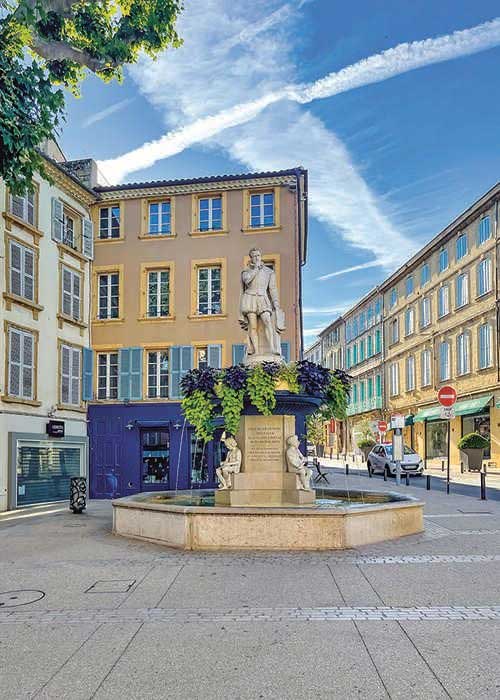
It’s not the first time International Living’s scouts have explored “Green Provence.” IL contributor Barbara Diggs was there five years ago. She loved the town of Aups, just 20 minutes from Cotignac. Here’s what Barbara had to say…
“Aups is a pretty market town nestled amongst a swathe of olive groves, forests, and lavender fields. Once a Roman settlement, Aups is an officially designated “city of character” thanks to its well-preserved historical center. The past feels well present here as you wander its narrow medieval streets, casually brush by the occasional Roman artefact, gaze up at the stone ruins of a 12th-century castle or marvel at the town’s many Renaissance-era sundials.
“Every Wednesday and Saturday, there’s a jam-packed market in the town’s main square, offering the usual tempting goods of local olive oil, lavender, honey, tapenades, fruits, vegetables and the eye-catching linens and pottery that are typical of Provence. But the Aups market’s moment to shine is during winter months when it features the region’s most coveted delicacy: black truffles—a hard-to-find fungi that only grows underground. People come here from all over Provence to buy these “black diamonds” of the culinary world.
“During off-season Aups has a population of about 2,000, but this number swells dramatically during summer months as French and foreign tourists pour in. The town is the “gateway” to the Verdon Gorge and is only a 30-minute drive from the marvelously blue waters of the Lac de Sainte-Croix, making it a perfect home base for nature lovers,” says Barbara.
Given its proximity to the Verdon Gorge, real estate prices in Aups are reasonable. For example, as we go to press, in the heart of the town, there’s a fully renovated village home for sale at €127,500 ($136,050).
When the Cicadas Sing
“Would you like an aperitif to start, madame?” My server at Picotte asked, in English, as he placed the drinks list on my table. I went with a local rosé, but was delighted to spot Pastis—the south’s rich, anise-flavored liqueur— and a coupe de Champagne à la lavande, a glass of lavender-flavored Champagne on the menu.
The set lunch menu was €30 ($32), and my starter of baked parsnip “fries,” arranged on a bacon-infused emulsion sauce, was both delicate and rich in flavor.
A retired French couple next to me seemed to be just as taken with Picotte’s offerings. We exchanged a few words, and oohed, ahhed, and ooh-la-laed together as each new dish arrived.
I felt like I was falling under the spell of Cotignac.
My morel-mushroom stuffed chicken breast was fit for a queen, and when dessert arrived (a matcha tea crème brulée) it was hard to say our au revoirs to such a wonderful lunch.
Squeezing between our two tables, our waiter chatted with my neighbors.
“Thankfully we didn’t come when the cicadas sing,” said Madame, giggling like a schoolgirl. This was a reference to the loud tsk-tsk-tsk mating call of the cicada, which signals the unofficial start of summer in the south of France. And a nod to the restaurant’s popularity…this place was bound to be booming during the summer season.
“Madame, was everything to your liking?” my waiter turned from the couple to my table.
Savoring the tail-end of an exquisite meal, with friendly tablemates, excellent service, and a waiter who spoke to me in my own language, I felt like I was already falling under the spell of Cotignac.
Things To Do in Green Provence
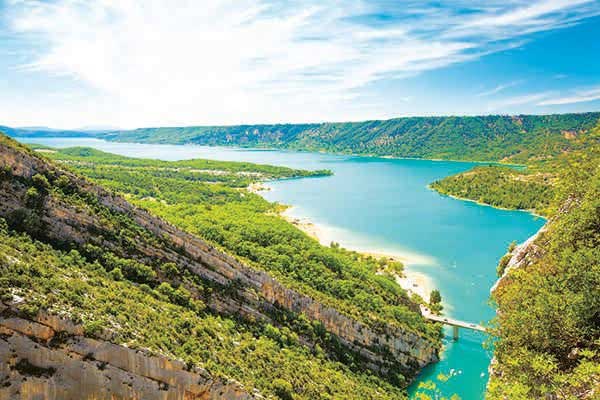
The Gorges du Verdon: Carved over thousands of years by the River Verdon, the Gorges du Verdon is one of the largest canyons in Europe. Located between the towns of Castellane and Moustiers-Sainte- Marie, the height of the limestone cliffs ranges from 820 to 2,300 feet. You can hike around the canyon or if you’re more adventurous, you can kayak or canoe in the river at the bottom of the canyon. It also makes for a good road trip. La Route des Crêtes is a 15-mile circuit around the canyon where you can stop off at viewing points and visit small, traditional villages along the way. Keep an eye out for peregrine falcons and vultures circling the skies above.
Take to the Many Hiking Trails: Green Provence has no shortage of hiking trails. The area has almost 250 miles of trails with 40 well sign-posted routes. And you don’t need to be an experienced hiker to enjoy the trails. There are paths and routes to suit every level of ability from a relaxing meander to more energetic and challenging hikes. You can even walk part of the St. James’s Way, the pilgrim path between Rome and Santiago de Compostela. Part of it, the GR653A footpath, passes through Green Provence.
Picnics Along Lac de Sainte-Croix: If you prefer your activities to be a bit more relaxing, check out Sainte-Croix Lake. It’s a man-made lake that was created in 1974 with the building of the Sainte-Croix dam and is six miles wide and one mile long. The villages of Bauduen, Les Salles sur Verdon, and Sainte-Croix-du-Verdon are the only three places where you can get direct access to the lake. Famous for its vivid turquoise blue waters, there are plenty of little beaches on which to relax around the lake. Grab some nibbles and wine and a picnic blanket and while away a couple of hours peoplewatching in the sun.
Go Wine Tasting: This area of France has been producing wine for over 2,000 years and many of the wineries in operation today offer tastings and tours. One such winery is Château Vignelaure, about a 50-minute drive west of Cotignac. The first vines were planted here in 1966 with the first vintage (a red) produced in 1970. With 55 acres of vines, they are famous for their red wines but also make whites and rosès. Their wine cellar is carved out of limestone rock and the wine is aged is oak casks. You can take a tour of the winery and follow it with some tastings and they also have an art gallery. For more see: vignelaure.com.
Related Articles
Exploring Cotignac, Provence: One of France’s Most Beautiful Villages
5 Best Cities and Towns to Live and Retire in France
5 Places to Live in France; 2 to Avoid
Upcoming Conferences
The Only 2024 Fast Track Panama Conference
If your dream retirement involves stunning beaches… lush green mountains… a warm climate with no hurricanes… first-rate healthcare… incredible value for money (a couple can live well on $2,200 a month)… and the World’s #1 Retiree Discount Program…
Join our Panama experts and expats in February and discover why Panama could be your perfect paradise.
REGISTER NOW, SEATS LIMITED: EARLY BIRD DISCOUNT HERE
Popular Articles You May Also Like

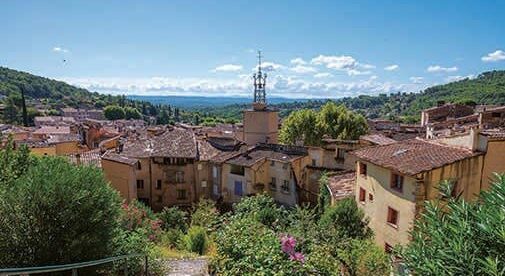
.png)